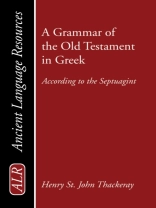Thackeray’s treatment of the Septuagint’s grammar is a masterful reference work, which moved Septuagintal study forward.
‘Why write a Grammar of a translation, in parts a servile translation, into a Greek which is far removed from the Attic standard, of an original which was often imperfectly understood? A sufficient answer might be that the work forms part of a larger whole, the Grammar of Hellenistic Greek, the claims of which, as bridging the gulf between the ancient and the modern tongue upon the attention of philhellenes and philologists have in recent years begun to receive their due recognition from a growing company of scholars. The Septuagint, in view both of the period which it covers and the variety of its styles, ranging from the non-literary vernacular to the artificial Atticistic, affords the most promising ground for the investigation of the peculiarities of the Hellenistic or ‘common’ language . . . Though of less paramount importance than the New Testament, the fact that it was the only form in which the older Scriptures were known to many generations of Jews and Christians and the deep influence which it exercised upon New Testament and Patristic writers justify a separate treatment of its language. Again, the fact that it is in the main translation gives it a special character and raises the difficult question of the extent of Semitic influence upon the written and spoken Greek of a bilingual people.’
-from the Preface
Contents
I. Introduction
II. Orthography and Phonetics
III. Accidence
A propos de l’auteur
Henry St. John Thackeray (1869-1930) was Grinfield Lecturer on the Septuagint at Oxford. He was a noted expert on Josephus and the translator of the first English edition of The Grammar of New Testament Greek by Friedrich Blass. His work on the Septuagint includes Some Aspects of the Greek Old Testament and his contribution to Swete’s An Introduction to the Old Testament in Greek.







![Couverture du Brian Schrag & Julisa Rowe: Community Arts for God's Purposes [Chinese] 貼近神心意的社群藝術 Couverture du Brian Schrag & Julisa Rowe: Community Arts for God's Purposes [Chinese] 貼近神心意的社群藝術](https://static.worldofdigitals.com/thumb_webp/740/9781645083740.webp)




